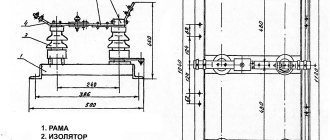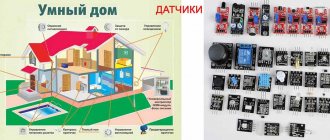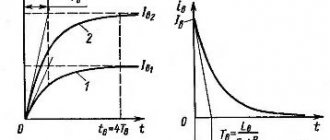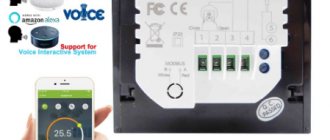How does remote light control from your phone work?
The development of smart home systems implies the emergence of ever new possibilities for convenient control of the devices included in its composition. One of them is the control of input voltages to consumer devices using a set of wireless communication equipment. Its incomparable advantage can be considered the convenience of changing the state of devices, without the need to lay additional communications between the “switches” and consumers. The word is put in quotation marks for a reason. The role of a controller that gives instructions for a break in the power line is not only a separate button, albeit wireless, but also a telephone, sensor or computer. An additional advantage is the ability to regulate voltage for the end user. In practice, it looks like controlling the light from a smartphone, not only by turning it on, but also by brightness. Or control the connection of household electrical appliances via the Internet.
Lighting control from a smartphone
General description of the scheme
The most common delivery schemes for WIFI smart home systems from various manufacturers contain switching units, wireless switches, a docking station for connecting to a common TCPIP network via a patch cord or WIFI. Control occurs using various low-level protocols, on which switching devices and power modules “communicate” between the line and consumers.
Equipment in contact with the home computer network is necessary for advanced management of the total volume of smart home endpoints, representing a kind of “brain” of the entire system. Various gadgets or “adult” PCs, as well as regular client remote controls, are connected to it via standard protocols.
With increasing miniaturization, you can find on the market not only simple controllers for all power units, but also those equipped with the additional ability to provide routing or direct connection to WIFI users.
Wireless switch equipment
In their development, the switches and power units themselves can also allow direct connection to themselves using more highly intelligent technology, but the price of such devices is higher.
Ways to control lighting from your phone
Using an external Wi-Fi switch
One of the lighting control options is the ability to use WIFI switches. They are mounted instead of the standard one already installed, and provide service functions for monitoring the supply of current to the consumer, both from a key fob or remote control, and from a cell phone.
The device itself is equipped with a touch plate, touching which opens or connects the voltage. There are options for supplying such a switch, which makes it possible to change the brightness of the lamps. Often, the device has backlighting or an indication of the presence of a network, which allows you to find control sensors even in complete darkness.
Connecting WIFI switch
Advantages
The size of the switch is standard and is perfect for installation in place of conventional breakers. The current consumption that the device can withstand is rarely less than 400W, which means that any type of lamp, not necessarily energy-saving, can be connected to the load. There are modifications for several consumers - there are devices with 2-3 pantographs.
To control lighting via WIFI from a smartphone, you just need to install a small application, the setup of which is very transparent for the end user.
Flaws
Despite the fact that you can install the device instead of old, manual circuit breakers, you will still have to redo the power system. Its connection is made according to a different principle - it is installed not to block the flow of current on one wire, but as an additional intermediary with the functions of a switch. That is, a phase and a zero must go to it, and consumers must already be connected from it. In practice, these are 2 wires from the panel to it, and two more to each lamp or socket.
Using the indoor unit
Schematic diagram of connecting the power module
The indoor unit is mounted directly into the housing of lighting lamps or sockets, at the break of the power line. This is both a plus and a minus of such switches. It is also possible to connect several controlled consumers to one module. Their number is much larger than for WIFI switches and can reach 32 pieces.
Advantages
As in the case of WIFI switches, the operation of power modules, and therefore lighting or any other consumer devices, can be controlled via the Internet or from a phone.
This can be very important in cases of “forgot to turn off the iron” or to create the effect of presence in an empty house.
In some cases, when access to the household switch itself is difficult (and it happens that it is firmly built into the wall), the use of a radio control power unit, which is installed directly at the consumer connection points, will help. Additionally, using an in-line line controller for new wiring makes circuit breaker installation easier.
In essence, there is no need to extend separate current flow channels to the switch. This is simply a stationary radio button, powered by a battery or accumulator, which is attached to any convenient place in your home. Power control modules can be perfectly placed in the panel itself.
Connecting the power unit and radio button
Flaws
It is difficult to talk about the shortcomings of such a system. These probably only include battery discharge over time. But this phenomenon is not common - manufacturers guarantee the operation of radio switches on one battery for up to 1.5 years (on average). In addition, the device itself will begin to signal in advance that the battery is low and the battery needs to be changed.
Another disadvantage is that if installation is carried out on old wiring, and the manual breaker is not removed and is used to disconnect the line, then the power module will also stop working.
And further. The control unit is not the smallest in size. In old lighting systems or sockets there may simply not be room for it in terms of dimensions. This point must also be taken into account when purchasing built-in power units.
Rules for developing a control plan and types of scenarios
In order to be able to remotely control the light in a house or area, you need to carefully work out the project, having at least minimal knowledge and experience in the electrical field.
As part of the lighting installation plan, professionals will carry out the following work:
- develop a plan for the placement of lighting equipment on the territory;
- combine lamps into circuits and sectors;
- select and lay the power cable in accordance with fire safety rules;
- They will install an automation panel for the required light scenarios.
Controlling the light from your phone is possible in the following scenarios:
- “Holiday” - the lights turn on in the house and on the site, you can adjust the color scheme or illumination;
- “Evening” - lighting of the garden area, gazebos;
- “Romance” - dim light in the corridor or on the paths in the garden;
- “Alarm” - lights flash throughout the house and garden area.
Connecting a remote lighting control system
First, choose a connection method. In the case of using a switch that acts as a replacement for a regular one, you need to take into account the connection of the line to it and the consumer. If a separate, built-in power unit is used, then a power cable to the lamp or socket itself is sufficient.
Selecting a Wi-Fi switch
Wifi switch
The main parameter required in the case of a WIFI switch is its maximum throughput. The amount of consumer withstand current should be 1.5 times higher than actual use. That is, if there are 6 lamps of 100 W in a chandelier, then the breaker should be able to pass through 6 x 100 x 1.5 = 900 W.
If this condition is not met, the risk of a fire in the room increases several times.
Again, the wiring must also match the current draw.
Selection of power modules
Here, in addition to the already mentioned power consumption, as in the case of switches, it is necessary to take into account the range of action of the radio buttons and the power unit.
Of course, many manufacturers write about 50 meters or more, but the reality is that these parameters are indicated only for cases where there are no obstacles between the equipment. That is, reinforced concrete walls separating the radio button and the power module, for example, will greatly reduce this distance.
Radio switch with three power blocks
System connection procedure
It all depends on the equipment used. If an intermediary docking station is used, the connection is configured to it. In the absence, but in the presence of devices that allow direct control via WIFI, a connection is made to each of them.
The setup process is fully described in the documentation that comes with the switch or general control unit. The only point worth mentioning is that the radio buttons themselves, in the case of using built-in power modules, also need to be “linked” to a specific line breaking node.
Setting up an Internet network and Wi-Fi
One of the types of network gateways
If the system contains a common docking station, then it must be connected to a home network router, via the included cable or, after the initial settings, using WIFI.
The configuration change itself is made via the web interface from a computer or phone. The documentation indicates the address to which you need to make an initial call, then you just need to modify the parameters on the screen and save them for them to take effect.
If there is only one switch or power module and it has the direct ability to connect WIFI clients to it, then the default parameters for the network contact can be found in the instructions, and after connecting to it, you can configure it within the limits of its versatility.
The docking station will not only provide the opportunity to control consumer devices from a nearby phone, but also control them or lighting from a smartphone via the Internet.
Installation of a remote switch
Installation of a radio button
The placement of the remote switch itself depends on its type. In cases where a radio button plus a power module is used, the switching unit itself is mounted on the line break (or rather, the conductors are first connected to it, and then go from it to the consumer), and the switching device is attached in any convenient way to the desired location.
If a touch contact with radio control capability is used, then it must be installed on a prepared platform (or recess), where the power cable from the panel and the current consumer line are led.
Installing software on a smartphone
Software for Android or iOS smartphones, as well as computers that control power or light control devices, can be found both on Google Play and on the manufacturer’s website. It is not necessary to use special software - the web interface functions typical for such devices may be sufficient.
Manufacturers
In the Russian market, the ability to control light from a phone is implemented by the following companies:
- It is a socket that connects to lighting fixtures between a regular socket and a light bulb and is controlled via a Bluetooth connection. The owner of this cartridge is invited to download an application for Android or iPhone to control the cartridge. This ensures low cost and versatility. SwitchEEL provides control of integrated groups of lighting fixtures, control over lighting intensity and many other useful functions.
- LIFX Labs. The technology for controlling light from a phone from an American company is carried out using Wi-Fi communication and access to a special application for mobile devices. The functionality of the control system includes changing the hue and brightness of the light, as well as standard turning it off and on. It is possible to activate the timer.
Manufacturers of lamps for controlling light from your phone
- Z-Wave. The company introduces remote control of lighting fixtures from a phone. By accessing a special application, you can turn on and off individual light bulbs or groups of lighting fixtures.
Why do I need smart light
So, with nooLite you can control the light very flexibly. But a reasonable question may arise: why? You've probably encountered one of the scenarios in which the nooLite wireless system would be very appropriate:
- When we bought a new cabinet, the switch prevented its installation, and damaging the walls to move the wiring was not an option.
- If a child cannot fall asleep without light, and every time after that it is too lazy to get up and go turn off the light.
- If you want to control the light while lying in bed with your favorite book.
- To turn off the lights in the entire apartment with one button before leaving home.
- To turn on street lighting from anywhere on the site.
- To control lighting and other electrical equipment from a computer, smartphone or tablet.
- When there are many light sources, but you want to control them in groups.
- If a small child cannot yet reach the wall switch, but you want to give him the opportunity to turn on the light.
- When you want to control the light in the bathroom additionally from the bathroom itself.
Which artificial lighting to choose
There are many types of artificial light: vacuum, halogen, krypton, fluorescent, xenon, mercury, metal halide, neon, argon, LED, sodium lamps and others.
For each room, depending on its purpose, it is necessary to select its own artificial lighting. For the bedroom, dining room and living room, warm white light (with a color temperature of 3-4 thousand K) is recommended. For the office and generally any work that requires attention - bright neutral, daytime (4.5-5 thousand K). Cool white light (5.5-6 thousand K) is better suited for the bathroom and cooking, but it will make your eyes more tired, so such lamps should be used for a short time.
Motion and lighting sensors
The use of motion sensors for artificial lighting is as common as for solar control.
Lights in the hallway, closet or garden that turn on themselves as soon as you approach them or open the door, and turn off when no one is there, are perhaps the most obvious use of such sensors. They are often used in lamps above the front door or on stairs, which turn on only when there is someone on the threshold. Such lamps are a real salvation for a person with busy hands. And a bright light in the garden, illuminating the area when someone has entered it, is an excellent protection against thieves.
The light sensor is another useful sensor. This could be the same sensor that closes the curtains at night, only controlling the lighting. Evening came? The decorative lighting of the paths in the garden is automatically turned on.
Such sensors can control lamps and fixtures in all rooms, as well as other electrical devices. Connected, for example, to a home control system, it can launch a whole lighting scenario: first illuminate the paths in the garden, then turn on the colored lighting of the house facade, and then activate the night mode of indoor lighting in the house.










